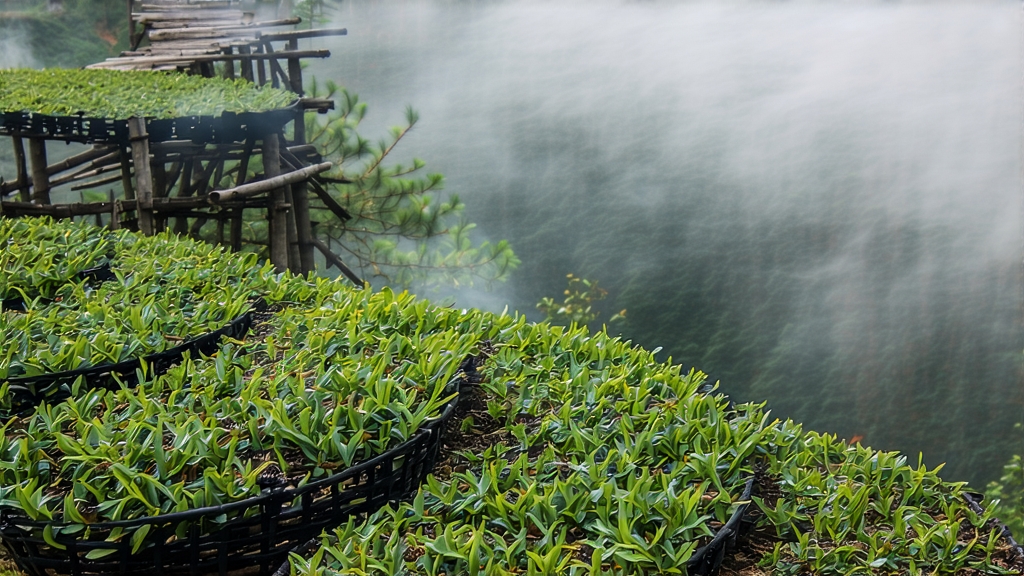
When European tea drinkers first encountered the dark, twisted leaves that produced a liquor the color of claret and a scent reminiscent of a campfire, they did not yet have a word for “black tea.” In the early seventeenth-century ports of Amsterdam and London the cargo was simply called “bohea,” a corruption of the Fujianese place-name Wuyi. That original bohea was Lapsang Souchong—today celebrated as the first fully oxidized tea ever created and the direct ancestor of every subsequent black tea on earth.
Geographic Birthplace
The Wuyi Mountains of northern Fujian province form a UNESCO-listed sandstone gorge where 36 peaks and 99 valleys trap humid maritime air. Morning fog lingers until noon, filtering sunlight and forcing the tea bush (Camellia sinensis var. sinensis) to produce extra polyphenols as natural sunscreen. It is in the village of Tongmu, perched at 1,200 m along the Jiuqu (“Nine Bends”) Stream, that Lapsang Souchong is still hand-crafted inside wooden houses whose rafters are blackened by decades of pine smoke.
Two Families, One Leaf
Local legend speaks of two Song-dynasty military officers who retreated to Wuyi and became monks. Searching for a way to preserve the spring harvest during a Qing army passage, they spread fresh leaves on pine racks above the cooking fire. The accidental smoking produced an intoxicating aroma that traveled faster than any imperial courier. By 1646 the first chest reached the Dutch East India Company, and by 1669 the British East India Company listed “Lapsang” at 21 shillings per pound—more than twice the price of silver.
From Souchong to Congou
The term “souchong” refers to the fourth and fifth leaves down the stem—larger, tougher, and more tannic than the prized bud sets used for green tea. Because these leaves oxidize quickly, they demanded an immediate and drastic intervention: smoking. Over centuries three commercial grades emerged:
- Traditional Leaf-Grade Lapsang: whole souchong leaves with a glossy jet color and a tight twist.
- Broken Lapsang (BP—Broken Pekoe): smaller particles created during rolling, yielding a stronger cup favored in Russian samovars.
- Artisanal “Wild Lapsang”: picked from semi-wild bushes growing among rhododendrons and orchids, lightly smoked for only two hours to preserve floral notes.
Crafting the Smoke
The process begins at dawn when pickers climb bamboo ladders to harvest one leaf and one bud, but only after the dew has evaporated—any surface moisture would trap harsh resins. The leaves are withered across latticed bamboo screens suspended over dying embers of native Masson pine (Pinus massoniana). The temperature is kept below 80 °C so the leaf cells remain alive while moisture drops from 75 % to 45 %. Once supple, the leaves are rolled on rattan trays until the edges bruise and redden, signaling the onset of oxidation. Instead of being moved to climate-controlled troughs, the leaf is heaped into pine-wood crates and carried to the smoking loft—a second-story room whose floorboards are spaced two millimeters apart. Here, slow-burning pine boughs smolder beneath, and the leaves absorb the cool, aromatic smoke for six to eight hours. A master smoker judges readiness by sound: when a handful of leaves rustles like autumn foliage, the firing is complete. Finally the tea is pan-fired at 120 °C for 30 seconds to set the smoke and reduce moisture to 3 %.
Chemical Alchemy
Gas chromatography reveals the signature molecule: trans-2-decenal, a fatty-acid derivative also found in coriander leaf that delivers a citrus-sage top note. Guaiacol and 4-methylguaiacol supply the campfire heart, while longifolene—rare in tea—adds a balsamic finish that lingers on the palate for up to 20 minutes. Together these compounds create the phenomenon known in Chinese as “yan yun” (smoky rhyme), a cooling sensation that paradoxically refreshes despite the robust aroma.
Brewing the Perfect Cup
Western Method: Use 2.5 g of leaf (one heaping teaspoon) per 250 ml of freshly drawn water at 95 °C. Steep for 4 minutes. The liquor should glow like antique mahogany and carry a clean, lingering sweetness.
Gongfu Method